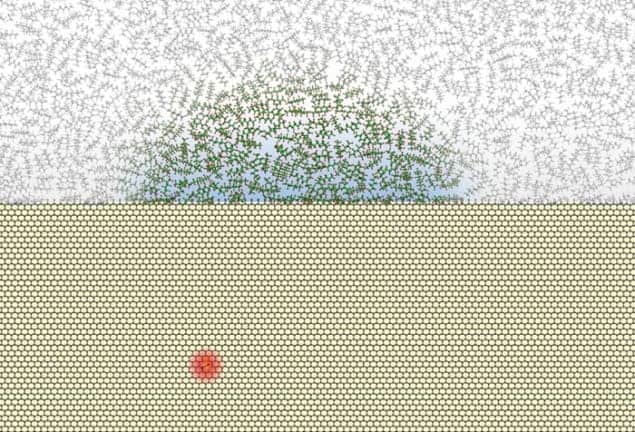
Magnetic-resonance-imaging technology has been shrunk to the nanoscale by two independent teams of researchers, so that molecular samples just a few cubic nanometres in volume can now be detected and imaged at room temperature. Both groups used nitrogen-vacancy defects in diamonds as magnetic-field sensors to probe such minute samples. The research could be the first step towards complete 3D molecular-scale magnetic resonance imaging (MRI) and nuclear magnetic resonance (NMR).
Classic images
Classical MRI and its related chemical-diagnostic technique NMR are useful tools as they can be used to study samples and even living organisms non-invasively. However, once a sample is smaller than, say, a few microns, the technique does not have the required sensitivity to work well. This is because a part of the apparatus – the antenna or the magnetic induction coil – that collects the magnetic signal from the sample being measured cannot be made any smaller than a few microns, and so it cannot pick up a signal from tiny volumes. Other methods, such as magnetic resonance force microscopy (MRFM), have been developed to image on very small scales but these only work at ultralow temperatures and so cannot be used outside the lab in an ambient environment.
The new method uses nitrogen vacancy (NV) defects, which occur when two neighbouring carbon atoms in diamonds are replaced by a nitrogen atom and an empty lattice site. NV sites are capable of detecting the very weak oscillatory magnetic fields that come from the spins of protons in a sample.
Defects and vacancies
Tobias Staudacher and Friedemann Reinhard of the University of Stuttgart, Germany, and colleagues used these NV defects to record the NMR spectra of various materials that they placed on the surface of a diamond. First the team embedded a single NV defect 7 nm under the surface of the diamond. “On a quantum level, our NV is in a two-spin state – a bright and dark fluorescence. So we set up a very basic quantum algorithm or protocol – the spin flips from bright to dark only if it detects the proton’s oscillations, and we can detect this with a photodiode or camera,” explains Reinhard. The team used this method to detect the proton spins of a number of liquid and solid samples placed on the diamond’s surface.
To build up an actual 3D image on the nanoscale, however, the sample would somehow need to be moved; but as the current method involves placing it on the diamond surface, this is not possible. Instead, Reinhard and his team are currently developing a diamond (with an NV defect) atomic force microscope (AFM) tip that could be used like a scanning device to image a sample in full 3D. “We are quite optimistic about this method and have been building this device for a while now,” says Reinhard.
He also points out that while being able to carry out the procedure at room temperature is a huge advantage, the team will also build some units of the diamond AFM device for low-temperature studies. He tells physicsworld.com that many samples, such as proteins, need low temperatures during imaging as they “move and shake too much at room temperature, so freezing them would give a more accurate image”.
Diverse applications
Reinhard claims that apart from the most basic application – being able to resolve a single atom at room temperature – in the future the method could have many other applications. He claims that the technique could help solid-state researchers and the nanotechnology community image their tiny devices, where “each atom in a device matters”. Currently, nanotechnology researchers can only image the surface of their devices. “Using this technique, they could selectively and chemically image below the surface,” says Reinhard.
Another potential application of the method includes using it as a polarizing agent for traditional NMR. This would involve polarizing the NV defect and transferring this polarization from the defect to the sample.
The method could also be applied to quantum information storage – single spins have been stored and then recovered from an NV, providing a way to store information in a quantum computer.
Manipulative measurements
The other group included Dan Rugar and John Mamin of the IBM Research Division in California, US, and colleagues. The researchers also used NVs in a diamond, just under its surface; however, their sample was not on the diamond surface itself but placed next to it. Their sample was an organic polymer. They manipulate the electron-spin echoes on the NV defects as well as the sample’s spin with an additional radio-frequency field to manipulate the electrons in the hydrogen atoms in the sample. The team believes that the sensitivity of the technique could, someday, even allow single protons to be resolved.
The research is published in Science.



